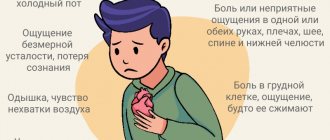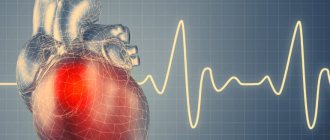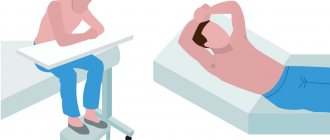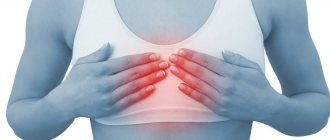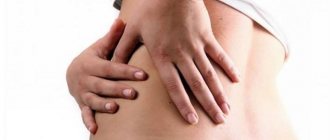Heart pain bothers every second person. They can be caused by various reasons and factors. For example, heredity, stress and emotional stress, physical stress, pressure changes. Pain in the heart area when taking a deep breath has also become a common problem today. This symptom bothers the patient, makes him worry and disrupts the normal functioning of the entire body.
Pain in the heart when inhaling can have different intensity, character and frequency. Most often, patients notice a cutting, pulling and sharp character, which continues with short pauses. Why does my heart hurt when I inhale? To answer this question, you should visit a doctor and conduct a full diagnosis of the body. Often such symptoms indicate the development of diseases of other organs. We recommend having a comprehensive examination at the KDS Clinic.
Heart hurts: types of pain
Pain in the heart area is not always the same.
They depend on the cause that causes them, as well as on the individual characteristics of the person. According to statistics, in 2021, more than 11.4 thousand new cases of only cardiac causes of chest pain were recorded in the Russian Federation, not counting diseases of other organs and systems.
How to understand what causes chest pain
The nature of the symptoms can sometimes indicate the cause of the pain. However, it is always better to consult your doctor. You can also take a short quiz to help you better understand the problem.
Sharp pain
Sharp, sudden pain in the heart most often occurs after exposure to a trigger, such as physical activity or emotional shock. Its duration depends on the provoking factor and can vary from 5-15 minutes during an attack of angina pectoris, to several hours during intercostal neuralgia. As a rule, such pain then completely disappears.
Acute pain
Acute pain in the heart includes strong, burning pain that occurs at rest or after exposure to a trigger. As a rule, a person becomes restless and a feeling of fear arises. The most common causes of acute pain in the heart are myocardial infarction and pulmonary embolism.
Stitching pain
Stitching pain behind the sternum, in contrast to sharp and acute pain, is less often accompanied by a significant disturbance in the general condition of a person. However, most often, it is also a sign of damage to the cardiovascular system, including: attacks of stable angina, inflammation of the heart and its membranes (myocarditis, pericarditis, endocarditis), valve defects, as well as psychogenic cardialgia.
Blunt pain
Dull pain in the cardiac region persists for a long time and allows you to perform everyday activities. When exposed to physical activity, it can worsen, become sharp or stabbing. The main causes are chronic heart diseases (for example, cardiomyopathies and heart failure that occur against the background of arterial hypertension), damage to the intercostal nerves and the spinal column in the thoracic region.
Pain when moving
A separate option is pain that occurs during movement (for example, bending the body to the sides or lifting weights) and disappears at rest. As a rule, it is rarely associated with other symptoms and indicates pathology of the musculoskeletal system in the thoracic region.
Pain when taking a deep breath
A type of pain syndrome in which discomfort and pain arise or worsen at the moment of deep inspiration. Most often it is associated with lesions of the bone frame of the chest and peripheral nerves in this area (for example, rib fractures and trauma to the intercostal nerves), as well as diseases of the respiratory system, including pulmonary embolism (PE).
Causes of the combination of pain and shortness of breath
Many factors affect your heart rate, breathing rate, and blood pressure readings. The main participants in regulation are the sympathetic and parasympathetic nervous systems, endocrine glands, and vascular receptors. A disruption in the functioning of one of these structures is indicated by increased blood pressure, symptoms of cardialgia and difficulty breathing. If you are worried about aching pain in the heart and there is not enough air, doctors understand the cause, since the situation can indicate many diseases. Patients with chronic cardiovascular pathology (diabetes, hypertension, coronary artery disease) should be more attentive to their health status when such signs appear. In such people, stabbing pain in the heart and shortness of breath may be associated with the following diseases:
- acute coronary syndrome, heart attack;
- inflammation of one of the cardiac membranes of the heart, pericardium, myocardium or endocardium;
- cardiomyopathy with severe hypertrophy of the heart;
- spasm of the coronary vessels against the background of ischemic disease, acute attack of circulatory failure;
- acute attack of angina after walking;
- a sharp increase in blood pressure, hypertension;
- complicated hypertensive crisis;
- pathology of the heart valve apparatus;
- bronchial asthma, severe broncho-obstructive syndrome;
- severe pneumonia, inflammation of the pleura of the lungs against the background of fever;
- pathology of the autonomic nervous system, neurocirculatory dystonia, VSD.
Breathing problems occur in patients with psychosomatic disorders and vegetative-vascular dystonia.
People who drink alcohol or use stimulants are especially susceptible to panic attacks. With this pathology, difficulty breathing is not accompanied by pain in the heart. However, a feeling of sudden fear causes neurotic shortness of breath, which occurs as a result of frequent deep breathing, hypercapnia and the release of adrenaline into the blood. In this case, the concern is:
- increasing anxiety and feeling of fear;
- convulsive and rapid breathing;
- feeling of suffocation;
- increasing shortness of breath and feeling of lack of air with every breath, cough;
- dizziness and weakness due to frequent inhalations and exhalations;
- sweating of the palms of the hands, face, back;
- inability to concentrate;
- increased heart rate and pulse;
- severe fatigue after an attack.
Cardialgia and shortness of breath appear against the background of increased blood pressure. Complaints of nausea or vomiting, heart pain and lack of air indicate a hypertensive crisis. Pain and a feeling of lack of oxygen intensify due to a sharp spasm of blood vessels, impaired cerebral circulation, and deterioration of general hemodynamics. The most dangerous is a sharp increase in blood pressure for pregnant women, since the risk of placental abruption, cerebral hemorrhage, and stroke increases significantly.
How does pain manifest when inhaling?
This can range from mild discomfort to severe pain localized behind the sternum (Fig. 1). As a concomitant symptom, shortness of breath often appears - the inability to take a normal breath and/or exhale. Horizontal position of the body, playing sports or emotional stress can aggravate pain and shortness of breath, causing a feeling of lack of air.
Figure 1. Chest pain when inhaling. Source: MedPortal
Causes of pain when inhaling
Normally, at the moment of inhalation, the volume of the thoracic cavity increases due to relaxation of the diaphragm and contraction of the intercostal muscles, which lift the ribs upward. This reduces the pressure in the lungs and fills them with air.
Therefore, often the appearance of pain in the heart area when inhaling may in no way be associated with cardiac problems and requires a thorough diagnosis of the bone frame of the chest and the respiratory system.
Cardiac causes of pain in the heart area when inhaling also cannot be excluded, since they are extremely common among the population.
According to statistics, about 57% of the total number of deaths is associated with diseases of the cardiovascular system, and the total number of deaths due to heart problems reaches 17.5 million cases annually.
You cannot ignore pain in the heart area, no matter what it is. Especially if the last preventative visit to your family doctor or general practitioner was a very long time ago, and also if there are other cardiovascular risk factors.
Important! Conditions that increase the risk of developing myocardial infarction and other cardiovascular diseases include:
- Arterial hypertension.
- Overweight and obesity.
- High levels of lipids and triglycerides in the blood.
- Physical inactivity is a lack of physical activity.
- Smoking and alcohol abuse.
- Diabetes.
- Chronic stress and lack of sleep.
- The presence of myocardial infarction at a young age in close blood relatives.
In clinical practice, the SCORE scale is also used to calculate the risk of cardiovascular pathologies. To quickly calculate your risk of heart disease in 10 years, use the calculator.
How to determine the source of discomfort
To determine the diagnosis, evaluate:
- pain intensity;
- localization, irradiation;
- duration of the attack;
- time of occurrence, frequency;
- provoking factors (changes in posture, movements, physical work);
- which eases the pain.
Additional symptoms indicating non-cardiac causes of pain:
- elevated temperature;
- cough, hemoptysis;
- progressive shortness of breath;
- digestive disorders;
- profuse sweating;
- emotional instability;
- focal neurological symptoms.
Differences between cardialgia caused by heart disease and neurocirculatory dystonia:
| Sign | Angina pectoris | NDC |
| Age | From 30 years (for men), from 50 (for women) | Often from 12 to 30 years |
| Risk factors for coronary heart disease | Present | No |
| Nature of pain | Mainly pressing, squeezing | Sharp, stabbing, cutting, pulsating, dull |
| Localization | Deep in the chest | In the area of the heart, left half of the chest |
| Irradiation | In the arms, lower jaw, back, shoulder blade on the left | No |
| What causes pain | Physical activity, increased blood pressure or heart rate | Physical, emotional stress, body turns, deep breathing, fatigue, anxiety, depression |
| Connection with loads | Occurs at peak voltage | Not associated with stress, physical work distracts or relieves pain |
| Duration | From 2 to 20 minutes | From a few seconds to days |
| What relieves the symptom | "Nitroglycerine" | "Valerian", "Validol" |
| ECG changes | Transient ST segment depression and/or negative T wave | Not typical |
Source clarification algorithm:
| Provoked by physical activity | Angina pectoris, myocardial infarction |
| Accompanies meals with additional symptoms of damage to the digestive system | Diaphragmatic hernia, biliary colic, cardiospasm, diverticulum, dyskinesia of the gallbladder |
| Intensifies with deep inspiration and independent movements of the upper body | Pericarditis, pulmonary pathology, pleurisy |
| Increases with palpation of the chest | Intercostal neuralgia, trauma, spinal osteochondrosis |
| Other options | Aortic arch aneurysm, neurocirculatory dystonia, myocarditis, valve defects, cardiomyopathy |
In addition to examining and finding out the history of the disease, to determine the final diagnosis, the doctor prescribes:
- To confirm/exclude ischemic heart disease and angina:
- ECG;
- echocardiography;
- load tests;
- coronary angiography.
- X-ray of the chest organs;
- MRI of the spine;
- echocardiography;
- Ultrasound of the abdominal organs;
- FEGDS;
- study of gastric juice acidity;
- detailed blood test;
- rheumatic tests;
- Ultrasound of the thyroid gland, thyroid hormones;
- consultation with a neurologist.
When inhaling, pain in the heart area is associated with diseases of the spine, their features:
- exacerbations and remissions of cardialgia are identical to the course of osteochondrosis;
- symptom reduction from nonsteroidal anti-inflammatory drugs, muscle relaxants, and physical therapy;
- the occurrence of pain after stress on the back;
- lack of effect from nitrates;
- increased symptoms when coughing, deep breathing, turning the body.
Causes of pain depending on sensations
Diseases are rarely accompanied by only one symptom.
More often, other signs and sensations also occur (Table 1), potentially indicating damage to a particular organ. Table 1. Symptoms accompanying the most common causes of chest pain when inhaling
| Feel | Disease |
| A feeling of acute, burning pain in the heart area, which lasts from 5 to 15 minutes and is relieved by taking nitroglycerin under the tongue. May be accompanied by fear of death. | Angina pectoris |
| Symptoms are similar to angina pectoris. But, unlike the previous condition, pain in the heart area persists for more than 15 minutes, and taking nitroglycerin has no effect on it. | Myocardial infarction |
| Mild pain is accompanied by a feeling of strong, rapid heartbeat. The pulse may be more than 100 beats/min and may not correspond to the heart rate. Dizziness, general weakness, and lightheadedness also occur. | Arrhythmias |
| Sharp or dull pain that occurs immediately after an injury or a short time after it. Intensifies with movement and deep breathing. At rest, it may weaken or disappear altogether. | Damage to intercostal muscles, ribs |
| Discomfort or pain that begins to “prick” in the chest during a stressful situation or during emotional shock. Associated phenomena - increased heart rate, increased sweating, feelings of fear or anxiety | Anxiety or panic attack |
| Increased pain with deep breathing, cough with mucous or purulent sputum, increased body temperature to 38-39℃ | Pneumonia and other infectious diseases of the respiratory system |
| Chest pain that gets worse when you inhale. Inhalation is very difficult. The condition is often triggered by inhaling dust, pollen, or missing a dose of medication used to prevent attacks. | Attack of bronchial asthma |
| The appearance of pain is preceded by tingling and itching. Soon after the pain appears on the skin along the costal arch, rashes appear in the form of spots, and then blisters, which open and leave behind crusts | Herpes zoster |
| Stitching pain behind the sternum, worse when inhaling. Accompanied by shortness of breath, cough, drop in blood pressure, increased heart rate, fear | Pulmonary embolism |
Why can my heart pound when I inhale?
If your heart hurts when moving or after physical activity, such as fitness classes, training, running and fast walking, then this may be anginal pain. Their duration is usually from 10 to 15 minutes. As a rule, after stopping the load and restoring breathing, they disappear on their own without the use of any means.
As for heart pain, it is acute and occurs with a feeling of tightness in the chest. They can be observed in different areas of the body, extending to the arm, neck or shoulder blade. Moreover, even a deep sigh does not reduce the severity of the attack. At the same time, the patient may experience pressure changes and shortness of breath.
When the nature of the pain resembles an injection, then the problem may lie in the following reasons:
- Neurosis is characteristic of people who are often in an anxious state. The patient, when trying to take a deep breath, feels a sharp pain that prevents him from taking in a sufficient amount of air. With this condition, hiccups are often noted. After the painful attack is over, the left side of the chest may be retracted.
- Injuries (bruise, strong blow) – the pain is stabbing in nature. Similar consequences persist for a long time in people after injury or broken ribs.
- Renal colic - with a reflected attack, pain can manifest itself in the entire peritoneal region.
- Respiratory diseases. These include bronchitis, pneumonia and pleurisy. In this case, the membrane lining the chest cavity becomes inflamed, making breathing difficult. The course of these diseases may be accompanied by severe weakness in the body or manifested by additional symptoms in the form of severe sweating, fever and coughing attacks.
Possible causes for pain in the heart area also include pleural tumor, osteochondrosis of the thoracic area, intercostal neuralgia.
Feelings associated with heart disease
More often than others, pain that occurs in the heart area when inhaling is provoked by the following diseases of the cardiovascular system:
- Angina pectoris.
- Myocardial infarction.
- Pulmonary embolism.
Cardiological causes of heart pain are extremely varied and quite often nonspecific. However, there are a number of features that indicate a connection with heart disease.
For example, with myocardial infarction (Fig. 2) and angina pectoris, pain often radiates (“gives”) to the area of the left shoulder and shoulder blade, neck and lower jaw. As a rule, it is associated with exposure to triggers - physical activity, smoking, errors in taking necessary medications. In this case, there is often no connection with respiratory movements.
Also, with a heart attack, severe weakness, shortness of breath, a characteristic “fear of death” occurs, and cold, sticky sweat appears on the forehead. Other possible signs of this pathology are: heart rhythm disturbances, dizziness, nausea.
Figure 2. Symptoms of myocardial infarction. Source: MedPortal
In general, cardiac pain is often accompanied by fluctuations in blood pressure, both towards hypertension (above 140/90 mmHg) and hypotension (below 90/60 mmHg). Also, a clear marker of pain of cardiac origin is a violation of the rhythm of heart contractions and “pulse deficiency” - a phenomenon in which the heart rate does not correspond to the pulse rate in the peripheral arteries.
Cardiac problems are often combined with heart failure, which is accompanied by symmetrical swelling of the extremities and acrocyanosis - bluishness of the skin in areas of the body distant from the heart: fingers and toes, lips, ears, etc.
It is important to understand that cardiac diseases can “masquerade” as other pathologies, which makes them quite difficult to recognize. For example, with myocardial infarction with a focus of ischemia in the region of the posterior-inferior part of the heart, pain may occur in the center of the upper abdomen.
Difficulties in diagnosis are added by concomitant diseases, for example, uncontrolled diabetes mellitus, in which pain in the heart, even with the same myocardial infarction, may be absent due to diabetic polyneuropathy (a complication of diabetes mellitus in which damage to peripheral nerves occurs and can be accompanied by both pain and loss sensitivity).
Diagnostics and therapy
To make an accurate diagnosis, the patient will be sent to undergo a number of studies, including:
- Ultrasound. Will allow you to determine the presence of pathological disorders that can provoke heart pain. The lungs, heart, pancreas and stomach are examined.
- Laboratory blood test. With its help, you can differentiate pathology, having presumptive diagnoses.
- Carrying out echocardiography. Prescribed to patients when there is a suspicion of heart pathology.
- Electrocardiography. One of the effective diagnostic methods, thanks to which the doctor is able to obtain a detailed picture of the work of the heart muscle, to detect ischemia that can cause pain near the heart.
For pleurisy, pneumothorax or pericarditis, auscultation of the lungs is performed.
Diseases in which colitis in the heart when inhaling usually do not require surgical intervention. The only exceptions may be the presence of a tumor process and some forms of pneumothorax. Your therapist or cardiologist will tell you about further treatment steps.
To prevent the development of heart disease, it is necessary to give up bad habits, adhere to a healthy lifestyle, avoid stressful situations and not let illness take its course.
Sensations not associated with heart pathologies
The most common causes of pain in the heart area when inhaling, not associated with cardiac diseases, are:
- Pneumonia is inflammation of the lungs.
- Pleurisy is inflammation of the pleura, which can also lead to the accumulation of fluid in the chest cavity (hydrothorax).
- Damage to the ribs.
- Injuries of intercostal nerves.
- Gastroesophageal reflux disease and other lesions of the esophagus or upper stomach.
- Psychosomatic reactions.
Pathologies of the lungs and respiratory tract (Fig. 3) are accompanied by pain spreading over the entire surface of the chest, intensifying with inhalation and/or exhalation. The cough that occurs in this case is often wet and leads to expectoration of mucous or purulent sputum. An increase in body temperature to 39℃ is also typical.
Figure 3. Causes of pleural chest pain. Source: MedPortal
Rib lesions are always associated with previous chest injuries. The pain is directly related to the respiratory act and its depth. There may be swelling and bleeding on the skin at the site of the rib injury.
Pathologies of the nervous system, in particular the intercostal nerves and spinal roots, are always associated with chest movements and physical activity. In this case, pain often has a “girdling character” and is limited to 1-3 intercostal spaces. With infectious lesions of the nerve trunks, an increase in body temperature is observed, and a rash appears on the skin.
Chest pain caused by diseases of the gastrointestinal tract is directly related to food intake. They are often accompanied by “sour” or “rotten” belching, diarrhea or constipation.
With a psychogenic origin of chest pain, the provoking factor is always stress or emotional stress, and any objective changes, as a rule, are absent. At the same time, stabilizing the emotional state, including with the help of sedatives, brings relief.
When should you see a doctor?
Pain in the heart area is a dangerous symptom that always requires additional diagnostics and a search for its causes. It is important to understand that diseases of all organs and systems require appropriate attention and treatment. But in some cases, you can independently determine the danger of a developing condition.
For the first time in life, an acute attack of pain in the heart area always requires contacting emergency medical services. The same applies to people with previously diagnosed angina pectoris (a form of angina in which pain occurs only against the background of a trigger and is eliminated by taking nitroglycerin) if taking a previously effective dose of nitrates did not relieve the pain within 15 minutes of taking the drug.
The absence of a serious danger may be indicated by pain or discomfort behind the sternum, which occurs immediately after a sharp turn or tilt of the body, eating or taking a horizontal position after eating. This also includes short-term attacks of mild pain that occur against the background of strong experiences or stressful situations. In such cases, a scheduled visit to the doctor is recommended.
Important! Regardless of the characteristics of the pain, the presence or absence of radiation, other symptoms or provoking factors, diagnosis is necessary. Only a doctor's examination, laboratory tests, ECG and other studies can help accurately determine the origin of pain and exclude life-threatening conditions.
What to do before the ambulance arrives?
If myocardial infarction or pulmonary embolism develops, proper treatment can only be carried out in a hospital setting.
Even before the ambulance arrives, you should:
- Take one tablet of aspirin, nitroglycerin. Aspirin reduces blood clotting, nitroglycerin improves blood supply to the myocardium.
- Make breathing as easy as possible. It is important to provide fresh air. To do this, you need to open a window in the room and remove clothes that are constricting your chest, for example, unbutton the buttons of a shirt.
- Take a comfortable position. A semi-sitting pose can make breathing easier, which you can take by placing several pillows under your head and shoulders. Another option is a sitting position with your elbows resting on your knees or a table with your torso slightly tilted forward. (Fig. 4).
- Try to calm down and not panic. During stress, the heart rate, respiratory movements and the heart's need for oxygen increase. All this aggravates the course of myocardial infarction and pulmonary embolism and worsens the prognosis.
Figure 4. Poses that make breathing easier. Source: MedPortal
Treatment methods
If you experience sharp pain in your heart, you must take a sitting position and unfasten your collar and cuffs. If your blood pressure is elevated and you suspect an angina attack, you should take a nitroglycerin tablet. It is also important to provide access to fresh air into the room. If symptoms do not go away after 15–30 minutes, you need to call an ambulance.
The treatment regimen is selected individually, depending on the exact diagnosis, the patient’s age and other factors. During an exacerbation of diseases, hospital treatment may be necessary, but then it is necessary to follow doctors’ orders at home. Thus, the treatment regimen may include the following steps:
- taking medications - prescribed individually, necessary for long-term use for certain diseases;
- proper nutrition - to reduce the load on the heart, you need to avoid fatty and salty foods;
- surgery - is prescribed only if there is a threat to life due to a blood clot or heart defects.
At the Clinical Brain Institute, treatment is carried out both in an inpatient and outpatient setting. At the center you can receive 24-hour medical supervision, as well as recommendations for doing it at home. The effectiveness of treatment depends on the timely use of medications, as well as proper nutrition and other factors.
Treatment
Since chest pain during inspiration can be caused by pathologies of different organs and systems, their treatment tactics will vary significantly.
Myocardial infarction and pulmonary embolism can be treated with thrombolysis - intravenous administration of drugs that can “dissolve” blood clots. However, such procedures are effective in the first 4-6 hours from the moment pain appears. At a later date, other treatment methods are used.
Other cardiac causes may require normalization of blood pressure, heart rate with the help of appropriate medications, restoration of heart valve function by replacing them, etc.
Infectious lesions of the lungs, accompanied by pain in the heart area, may require the use of antibacterial or antiviral agents. For bronchial asthma, the treatment regimen includes β2-agonists, glucocorticosteroids, etc.
Gastrointestinal pathologies can be brought under control by normalizing nutrition and physical activity; doctors advise fighting obesity and taking medications that affect the pH level of the stomach cavity.
Intercostal neuralgia is treated with analgesics, non-steroidal anti-inflammatory drugs, B vitamins and muscle relaxants.
In case of psychogenic cardialgia, it is recommended to consult a medical psychologist or psychiatrist to decide on the need to use sedatives.
Prevention
Prevention of pain in the heart area when inhaling is complex and is aimed at strengthening the entire body as a whole and the cardiovascular system in particular. First of all, this is a healthy lifestyle: a rational schedule of work and rest, proper nutrition and moderate physical activity. Cardio training and yoga help control breathing and strengthen the heart muscle.
However, if you have concomitant diseases, it is important to coordinate all your actions with your doctor. For example, the doctor will help you control the level of fat and cholesterol you consume. This is important because they are part of cell membranes, and completely avoiding their consumption can be harmful.
Diagnostic methods
After the examination, the doctor will prescribe an examination regimen to assess the patient’s general condition and to understand the cause of pain in the heart area. It will include only those techniques that allow you to determine the cause of deterioration in health:
- blood tests - include general and biochemical studies, as well as determination of the level of cholesterol, lipids and other specific elements;
- ECG (electrocardiography) is a method of assessing the work of the heart, which consists of recording electric fields, can be carried out within a few minutes or 24 hours;
- Cardiac ultrasound is an informative diagnostic method that allows you to identify heart defects, anomalies in the structure of valves and large vessels;
- Ultrasound of vessels with the addition of a contrast agent - prescribed to assess the speed and intensity of blood circulation, the presence of blood clots;
- other methods - may include examination of the cervical spine, diagnostic tests, ultrasound of internal organs, fluorography.
At the Clinical Brain Institute, you can undergo a complete diagnosis if pain occurs in the head and heart. Modern equipment is located here, thanks to which it is possible to obtain accurate results in a short time. In addition, patients are offered comfortable conditions for placement in a hospital for the period of examination and manipulation.
Sources
- Trukhan D.I., Davydov E.L. “Chest pain: current issues in clinical diagnosis and treatment of angina” // Consilium Medicum – No. 17(10) – 2015.
- Yu. V. Vasiliev “Pain behind the sternum: differential diagnosis, treatment” // Cardiology - 2006.
- Ruigomez A., Rodriguez LA, Wallander MA et al “Chest pain in general practice: incidence, comorbidity and mortality” // Fam. Pract. – Vol. 23 – 2006
- A.N. Belovol, I.I. Knyazkova “Clinical approaches to the diagnosis of chest pain” // Current preparations and technologies – No2 (78) – 2011 r.
- Nilsson S., Scheike M., Engblom D. et al. “Chest pain and ischemic heart disease in primary care” // Br. J.Gen. Pract. – Vol. 53 – 2003.
